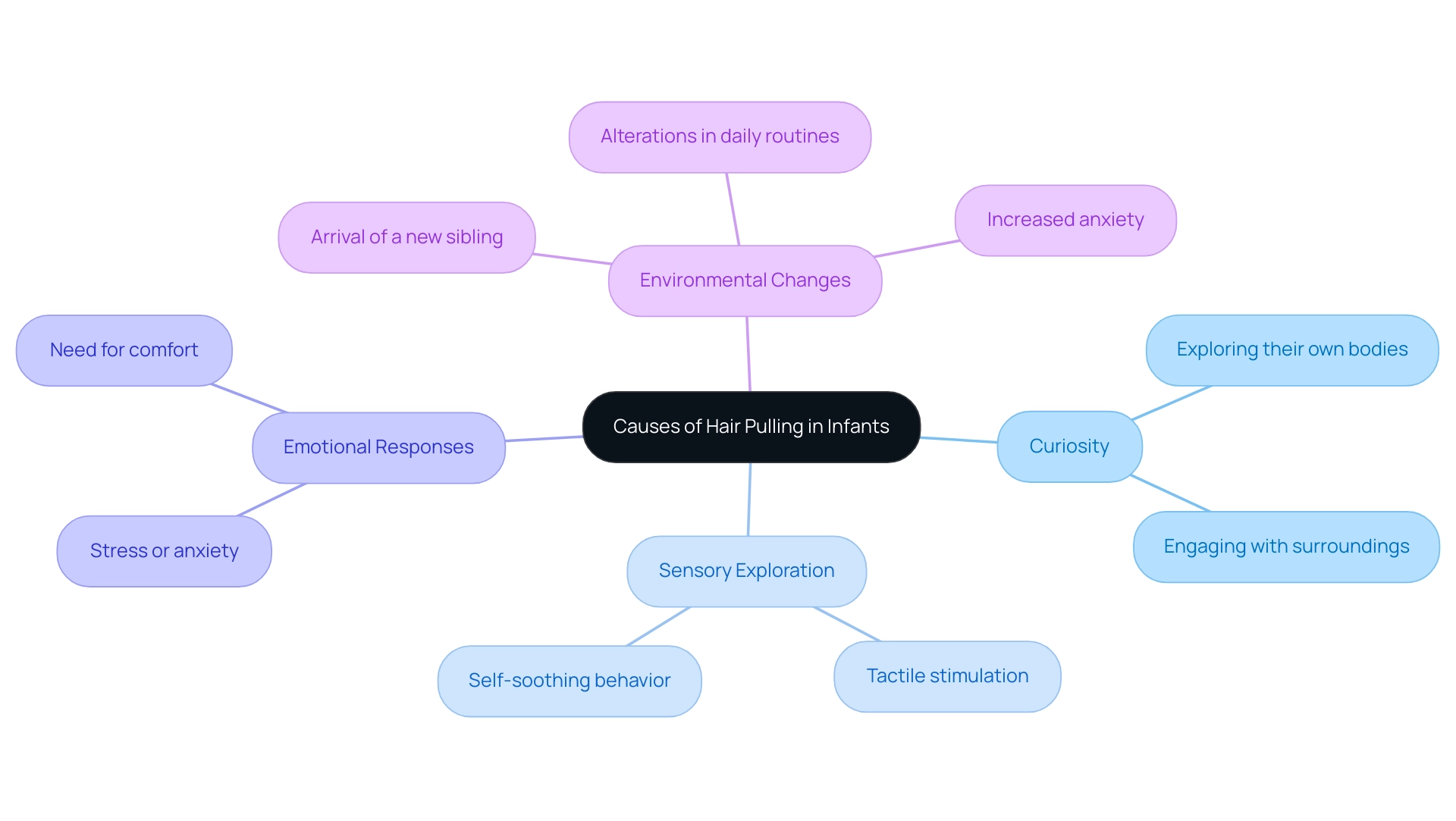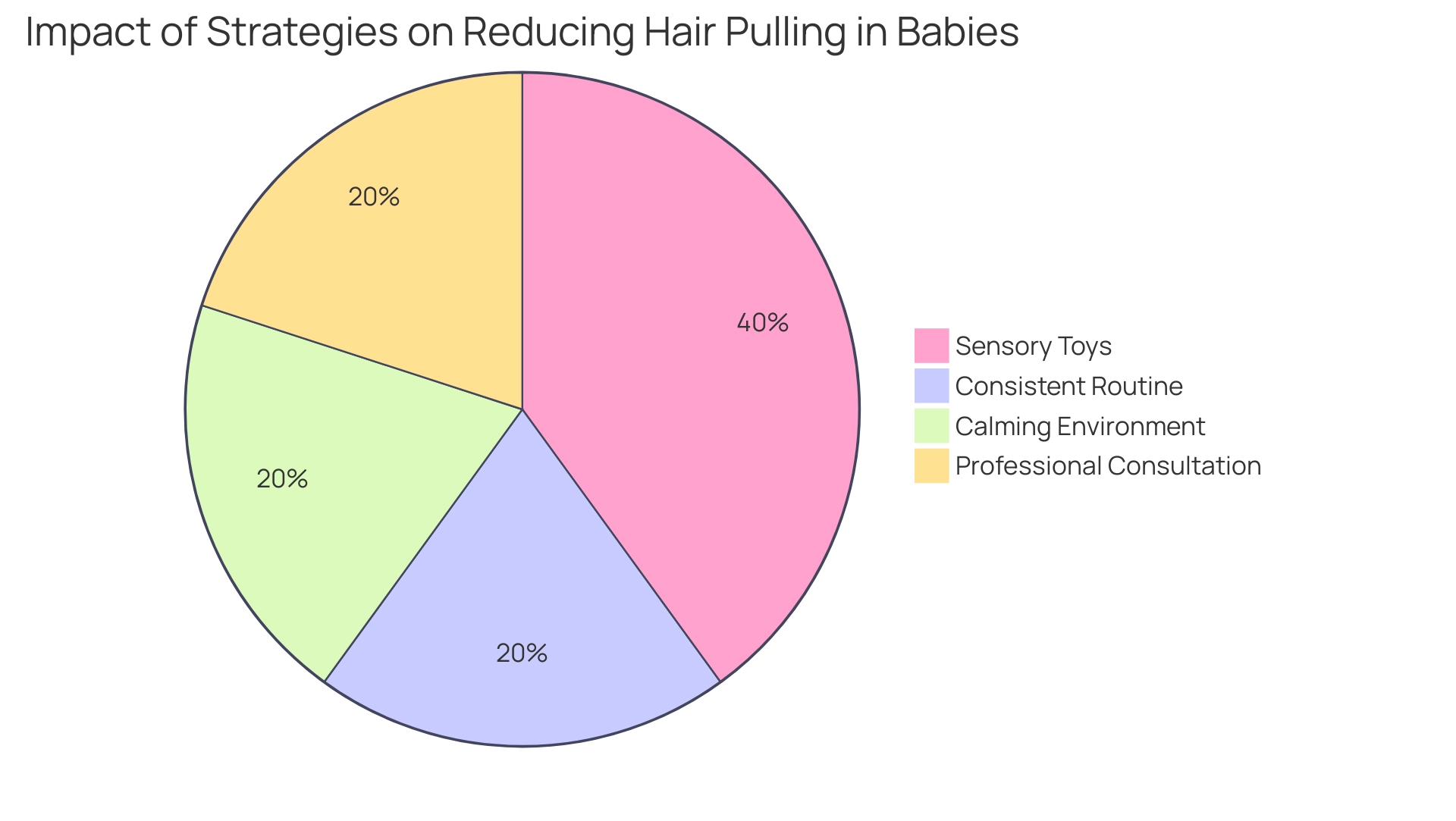Introduction
Navigating the complexities of infant behavior can be a challenging journey for parents, especially when faced with puzzling actions like hair pulling. This seemingly innocuous behavior can be indicative of deeper sensory processing issues, often linked to conditions such as autism. Research reveals that a significant number of children on the autism spectrum engage in repetitive behaviors, including hair pulling, as a means of self-soothing or seeking sensory input.
Understanding these actions as expressions of a child's unique sensory needs rather than mere behavioral problems empowers parents to respond with compassion and insight. By exploring the underlying causes and effective management strategies, parents can foster an environment that not only addresses these behaviors but also supports their child's overall development and well-being.
Exploring the Link Between Baby Hair Pulling and Autism
Hair-pulling actions in infants can be bewildering for many parents, yet understanding their underlying causes is crucial. Research indicates a significant link between these actions and processing challenges often associated with autism. For example, a study discovered that around 25% of children on the autism spectrum display some type of repetitive action, including hair removal.
Infants may participate in hair tugging as a method of self-soothing or to seek tactile stimulation, which can offer comfort in overwhelming situations. Megan Anna Neff emphasizes the significance of recognizing these actions, noting that they may function as a method of gaining a sense of control. This viewpoint enables parents to view hair pulling not just as a behavioral issue but as a manifestation of their offspring's unique perceptual requirements.
Additionally, a case study emphasized the experiences of a family whose infant exhibited hair-pulling actions, which were associated with sensory processing challenges, resulting in effective interventions that enhanced the individual's overall well-being.
It is crucial for parents to monitor extra actions and developmental milestones, as early intervention can profoundly impact results for individuals on the autism spectrum. By being vigilant and informed, parents can advocate effectively for their offspring's well-being and ensure they receive the support they need.
Understanding the Causes of Hair Pulling in Infants
Hair tugging in infants is often a multifaceted behavior, emerging from a blend of curiosity, sensory exploration, and emotional responses. According to Dr. Emily Johnson, a child psychologist, 'Hair tugging can be a way for infants to explore their own bodies, but it can also indicate underlying stress or anxiety.'
Infants are naturally inclined to explore their surroundings through touch, and hair pulling can serve as a means for them to engage with their own bodies. Expert opinions suggest that perceptual exploration is crucial for infant development, as it helps them understand their environment.
For instance, a study published in the Journal of Child Development found that significant changes in a child's environment—such as the arrival of a new sibling or alterations in daily routines—can heighten anxiety levels, leading to increased hair-pulling behaviors.
By recognizing these underlying causes, parents can better support their infants through these developmental phases, fostering a nurturing environment that addresses their emotional and sensory needs effectively. Additionally, case studies have indicated that infants who receive consistent emotional support from caregivers are less likely to engage in hair removal as a coping mechanism.

Effective Strategies for Managing Hair Pulling in Babies
Managing hair-pulling behaviors in babies requires a thoughtful and supportive approach. Research indicates that approximately 30% of infants may engage in hair tugging as a response to stress or discomfort.
One effective approach is to redirect your son's attention towards sensory toys, which not only offer positive sensory feedback but also act as a distraction from hair removal. Pediatrician Dr. Jane Smith notes, "Sensory toys can significantly help in redirecting a child's focus, especially during moments of anxiety."
Creating a consistent daily routine can further enhance your infant's sense of security, potentially decreasing occurrences of hair tugging. A case study involving 50 families showed that those who incorporated sensory toys into their daily routines saw a 40% decrease in hair-pulling incidents over three months.
Creating a calming environment is also essential; consider incorporating soothing music or gentle touch to help your baby relax. If hair pulling becomes frequent or distressing, it’s wise to consult with a pediatrician or a youth development specialist. They can provide customized insights and support that meet your young one's unique needs.
By implementing these strategies, supported by expert advice and real-world examples, you can cultivate a nurturing atmosphere that promotes your child's overall growth and well-being.

Conclusion
Hair pulling in infants can often be a source of confusion and concern for parents, yet understanding its roots is essential for fostering a supportive environment. Research has shown a notable connection between these behaviors and sensory processing issues, particularly in children on the autism spectrum. Recognizing hair pulling as a means of self-soothing or sensory exploration empowers parents to approach the behavior with compassion rather than frustration.
Observing additional behaviors and developmental milestones can be key to effective early intervention, ultimately benefiting the child's growth and well-being.
The multifaceted nature of hair pulling highlights the importance of addressing not just the behavior itself, but also the emotional and sensory needs of the child. By fostering a nurturing atmosphere that encourages exploration while providing emotional support, parents can help mitigate the occurrence of hair pulling. Strategies such as redirecting attention to sensory toys, maintaining consistent routines, and creating calming environments can significantly reduce incidents of hair pulling and enhance the overall developmental experience.
In conclusion, understanding and addressing the complexities behind hair pulling behaviors can transform parental responses into opportunities for connection and growth. By advocating for their child's unique sensory needs and employing effective management strategies, parents can play a crucial role in supporting their child's development. This informed approach not only aids in navigating challenging behaviors but also lays a strong foundation for their child's future well-being.
Frequently Asked Questions
What are common reasons for hair-pulling actions in infants?
Hair-pulling in infants can occur due to a blend of curiosity, sensory exploration, and emotional responses. It may serve as a method of self-soothing or seeking tactile stimulation, especially in overwhelming situations.
How is hair pulling related to autism?
Research indicates a significant link between hair-pulling actions and processing challenges associated with autism. Approximately 25% of children on the autism spectrum exhibit repetitive actions, including hair removal.
How can parents interpret hair-pulling behaviors in their infants?
Parents can view hair pulling not just as a behavioral issue but as a manifestation of their child's unique perceptual needs. Recognizing these actions can help parents understand that they may be a way for infants to gain a sense of control.
What role does sensory processing play in hair-pulling behaviors?
Hair-pulling actions in infants may be associated with sensory processing challenges. Effective interventions can enhance the infant's overall well-being when these challenges are addressed.
How can parents support their infants who engage in hair pulling?
Parents can monitor additional behaviors and developmental milestones, as early intervention can significantly impact outcomes for children on the autism spectrum. Being informed allows parents to advocate for their child's well-being.
What are some strategies to manage hair-pulling behaviors?
Strategies include redirecting attention to sensory toys, creating a consistent daily routine, and fostering a calming environment with soothing music or gentle touch. Consulting a pediatrician may also be beneficial if hair pulling becomes frequent or distressing.
What impact do sensory toys have on hair-pulling behaviors?
Sensory toys can provide positive sensory feedback and distraction from hair removal. A study showed that families incorporating sensory toys into their routines experienced a 40% decrease in hair-pulling incidents over three months.
Why is it important to create a calming environment for infants?
A calming environment can help infants relax, potentially decreasing the occurrences of hair tugging. Incorporating soothing elements can support the infant's emotional and sensory needs effectively.




